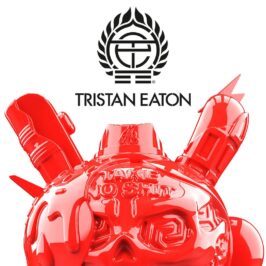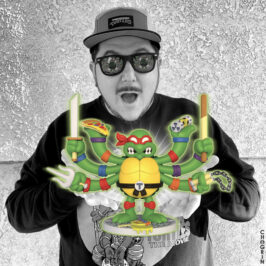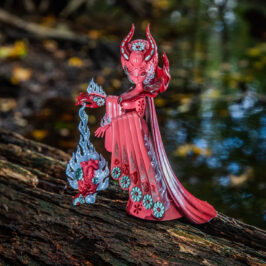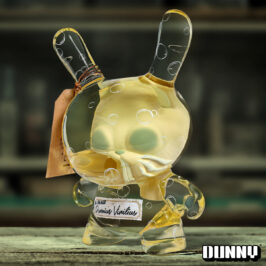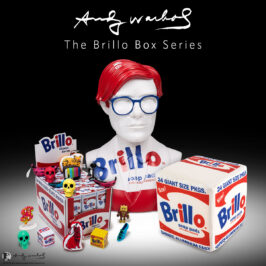
The next release in our 20th Anniversary Dunny Collection drops today exclusively on Kidrobot.com! The Kidrobot x Locknesters Puzzle Dunny 20″ Art Figure is an incredible new super sized design and celebration of the Dunny. We spoke to its creator, Fleet Hower, to see how he solved the puzzle of designing such a complex Dunny on such a large scale.
Kidrobot: Hi Fleet! How did Locknesters come about?
Fleet Hower: Locknesters are the product of a couple of interests of mine. When I was a kid, I was really into puzzles. Then, I grew up and went to architecture school. So, they’re kind of somewhere in the middle.
Kidrobot: Tell us about your design process.
Fleet Hower: I’ve always been interested in patterns and creating new patterns. They’re about the only thing I can draw. When I was a kid, I used to draw patterns on paper, and some would be based in lines, and some would be based in points, and some would be based in curves. And I was really curious about how you could draw different shapes and create a new pattern out of them. And it’s kind of a similar idea [with the Puzzle Dunny] where you’ve got these lines that are the divisions of the pieces, and then you’ve got this diamond pattern of small Dunnys. And the trick is to get them to work together.
Kidrobot: Reflecting on its 20th Anniversary, what does the Dunny mean to you?
Fleet Hower: The Dunny is really an iconic figure, and it’s been a real pleasure to work on them in the past. There have been so many great artists that have done one. For me, I’m really excited about doing this 20-inch version. There aren’t many at that size, and I think it’ll be really special.
Kidrobot: How does this 20-inch Dunny compare to your previous 8-inch ones?
Fleet Hower: I’ve done three 8-inch versions: a black, a blue, and a pink version. They’re each five pieces. This 20-inch version is a whole new level of complexity, and it’s 36 pieces total. With the 8-inch versions, you could assemble them as if you were putting a three-dimensional jigsaw puzzle together. With the 20-inch version, because of the complexity of the pieces, there’s an internal bolt system to hold the figure together.
Kidrobot: Was your approach different in designing for a larger scale?
Fleet Hower: With the 8-inch versions, the idea was to keep the division lines of the pieces very simple and kind of mimic the curvature of the Dunny form. It’s kind of the opposite with this 20-inch, where there’s a real fascination with detail on the surface and this idea of packing as much detail in on the surface as I possibly could. That’s where two different scales of smaller Dunnys come in.
Kidrobot: Tell us more about the surface detailing.
Fleet Hower: So, there’s kind of a simple pattern; it’s this diagrid pattern of very small Dunnys combined with a little bit larger version. There’s 11 of the larger Dunnys across the surface, and they kind of create these two different scales of detail that’s on the surface. I’m not much of a painter; I can’t really draw, but what I can do is produce 3D models. And so, the way I bring detail to a figure is through surface manipulation.
Kidrobot: Did you encounter any challenges along the way?
Fleet Hower: Designing this 20-inch version definitely brought with it some challenges that weren’t present on the 8-inch Dunny. Most of that has to do with the increase in surface area. There’s a lot of room for experimentation on the surface and cramming as much detail on the surface as possible.
There are a lot of ways to get creative when the Dunny is at this scale in the way you cut the pieces up. The challenge is really in getting the thing to hold together, figuring out how it’s not going to fall apart. And that’s where the internal bolt system really helped out.
Kidrobot: How does your finishing process work?
Fleet Hower: Something I’ve been interested in for a long time is the ability to produce and finish my own work. Once the basic pieces are made, they’re tumbled in a ceramic media for about a day. They come out of this process feeling very smooth, but they’re also pretty gunky and dirty, so they need to be cleaned up.
I do this by tumbling them again, this time in a corn cob media, for another 10 to 12 hours. And they come out of the corn looking a lot better. They feel very smooth, and they have this kind of worn look that’s pretty unique.
Kidrobot: Thank you for giving us insight into your work!
Fleet Hower: It’s been a real pleasure to have the opportunity to design a 20-inch Dunny. It feels really special at this scale. I hope you like it.
Order the 20th Anniversary Puzzle Dunny now!
